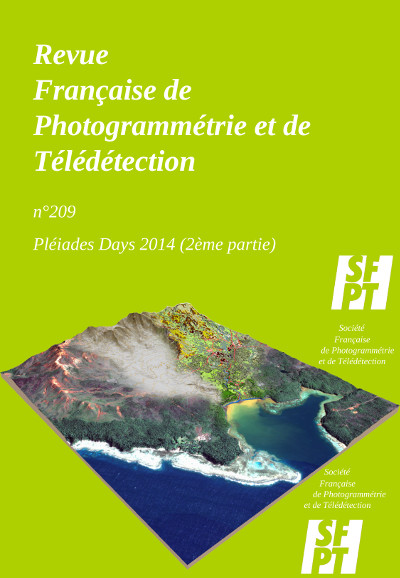L'apport de l'imagerie à haute résolution spatiale à la cartographie du risque de crue torrentielle
DOI:
https://doi.org/10.52638/rfpt.2015.129Keywords:
crue torrentielle, exposition, vulnérabilité, risques, photo-interprétation, classification supervisée, MonteverdiAbstract
Depuis les années 1980, la qualité croissante d'images satellites destinées à l'observation de la terre ouvre de nouvelles possibilités en photo-interprétation dans l'analyse des risques naturels, à la fois pour la prévision, la surveillance et l'analyse d'endommagement (Kerle et Oppenheimer, 2002 ; Domenikiotis et al., 2003). Suite à une crue torrentielle de février 2013 qui a affecté 93 bâtiments le long du chenal Avenida Venezuela dans la ville d'Arequipa, Pérou et endommagé 23 des 53 ponts, une étude a été menée en utilisant l'imagerie Pléiades. Des relevés de terrain ont servi de contrôle pour la cartographie du bâti et des infrastructures critiques sur deux images Pléiades respectivement d'avant-crue en 2012 et d'après-crue en 2013. Les objectifs de cette étude sont : (1) améliorer la cartographie de l'occupation du sol en milieu urbain sur des images Pléiades à résolution submétrique ; (2) tester l'apport de la classification supervisée semi-automatique à l'aide du logiciel Monteverdi (©CNES, Toulouse, France) ; (3) comparer la qualité des résultats et évaluer le potentiel de l'utilisation de la classification supervisée à partir des images Pléiades et (4) identifier l'impact de la crue torrentielle sur le chenal lui-même. Les résultats confirment une nette amélioration de la précision de la cartographie de vulnérabilité grâce aux images HRS à échelle locale. La délimitation d'objet est bien meilleure et la combinaison de la classification semi-automatique avec une digitalisation manuelle sous SIG donne des résultats très prometteurs.
Downloads
References
Birkmann J., 2006. Measuring vulnerability to promote disaster-resilient societies : Conceptual frameworks and definitions, In : Birkmann J. (ed.), Measuring Vulnerability to Natural Hazards — Towards Disaster Resilient Societies, New York, United Nations University, pp. 9-54.
Bogardi J., et Birkmann J., 2004. Vulnerability Assessment : The First Step Towards Sustainable Risk Reduction, In : Malzahn D., et Plapp T. (eds.), Disaster and Society — From Hazards Assessment to Risk Reduction, Logos Verlag Berlin, Berlin, 75-82.
Cacya L., Meza P., Carlotto V., Mamani L., 2013. Aluvión del 8 de Febrero del 2013 en la ciudad de Arequipa. Foro internacional Peligros geológicos, Arequipa, 14-16 Octubre 2013, GRM, OVI Ingemmet, Libro de Resúmenes, pp. 195-203.
Calianno M., Ruin I., Gourley J.J., 2012. Supplementing flash flood reports with impact classifications. Journal of Hydrology 477 : 1-16.
Cardona O.D., 2004. The need for rethinking the concepts of vulnerability and risk from a holistic perspective: a necessary review and criticism for effective risk management. In: Bankoff G., Frerks G., Hilhorst D. (eds.), Mapping Vulnerability: Disasters, Development and People. Earthscan Publishers, London.
Domenikiotis C., Loukas A., Dalezios N.R., 2003. The use of NOAA/AVHRR satellite data for monitoring and assessment of forest fires and floods. Natural Hazards and Earth System Sciences 3 : 115-128.
Ettinger S., Manrique Llerena N., Talibart C., Mounaud L., Yao-Lafourcade A.-F., Thouret J.-C., 2014. Using HSR imagery to downscale vulnerability assessment of buildings and local infrastructure facing hazards from floods and hyperconcentrated flows. Geophysical Research Abstracts, vol. 16, EGU2014-13978, EGU General Assembly 2014.
Faella C., Nigro E., 2003a. Dynamic impact of the debris flows on the constructions during the hydrogeological disaster in Campania 1998 : description and analysis of the damages. In : Picarelli L. (ed.), Proceedings of international conference on fast slope movements-prediction and prevention for risk mitigation (FSM2003), Napoli, Italy, 11-13 May, 2003, Patron, Bologna.
Faella C., Nigro E., 2003c. A hypothesis of technical code on the structural design and repairing in urban areas with high debris flow risk. In : Picarelli L. (ed.), Proceedings of international conference on fast slope movements-prediction and prevention for risk mitigation (FSM2003), Napoli, Italy, 11-13 May, 2003, Patron, Bologna.
Fuchs S., Heiss K., Hübl J., 2007a. Towards an empirical vulnerability function for use in debris flow risk assessment. Natural Hazards and Earth System Sciences 7 : 495-506.
Fuchs S., 2009. Susceptibility versus resilience to mountain hazards in Austria — paradigms of vulnerability revisited. Natural Hazards and Earth System Sciences 9 : 337-352.
Fuchs S., Ornetsmüller C., Totschnig R., 2012. Spatial scan statistics in vulnerability assessment — an application to mountain hazards. Natural Hazards 64 : 2129-2151.
Hollenstein K., 2005. Reconsidering the risk assessment concept : Standardizing the impact description as a building block for vulnerability assessment. Nat Haz and Earth Sys Sci 5 : 301-307.
Hong Y., Adhikari P., Gourley J.J., 2012. Flash flood. In: Bobrowsky P. (ed.), Encyclopedia of Nat. Hazards. Springer.
Keiler M., Zischg A., Fuchs S., 2006. Methoden zur GIS-basierten Erhebung des Schadenpotenzials für naturgefahreninduzierte Risiken. In : Strobl J., Roth C. (eds.), GIS und Sicherheitsmanagement. Wichmann, Heidelberg, pp. 118-128.
Kerle N., Oppenheimer C., 2002. Satellite Remote Sensing as a Tool in Lahar Disaster Management. Disasters 26(2) : 140-160.
MunichRe, 2013. TOPICS—GEO. Natural catastrophes 2012, Analyses, assessments, positions. 2012 issue, 66 p.
SENAMHI, 2013. Periodo de lluvias 2013 en la régión Arequipa y su relación con el Cambio Climático. Foro Regional Desastre, Reconstrucción y desarrollo en escenario de cambio climático Arequipa — emergencia 2013.
Thouret J.-C., Ettinger S., Guitton M., Martelli K., Santoni O., Magill C., Revilla V., Charca J.A., 2014. Assessing physical vulnerability and risk in large cities exposed to debris flows and flash floods: the Arequipa (Peru) case study. Natural Hazards, DOI 10.1007/s11069-014-1172-x, 47p.
Totschnig R., Fuchs S., 2013. Mountain torrents : Quantifying vulnerability and assessing uncertainties. Engineering Geology 155 : 31-44.
Tralli D.M., Blom R.G., Zlotnicki V., Donnellan A., Evans D.L., 2005. Satellite remote sensing of earthquake, volcano, flood, landslide and coastal inundation hazards. ISPRS Journal of Photogrammetry & Remote Sensing 59 : 185-198.
Uzielli M., Nadim F., Lacasse S., Kaynia A.M., 2008. A conceptual framework for quantitative estimation of physical vulnerability to landslides. Engineering Geology 102 : 251-256.
World Bank, 2010. Natural Hazards, Unnatural Disasters: The Economics of Effective Prevention. Washington.






